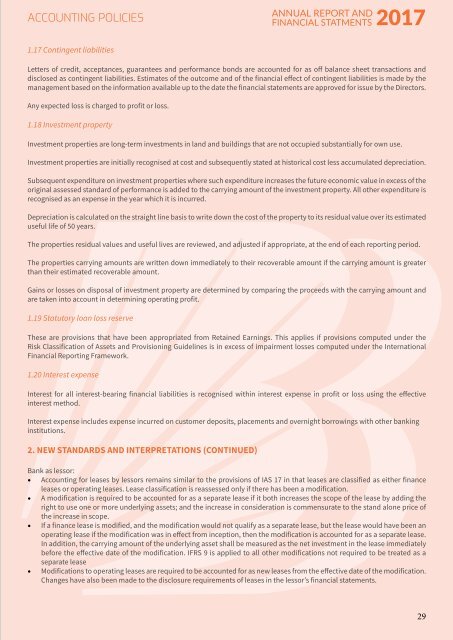BOB_2017_SMALL
Create successful ePaper yourself
Turn your PDF publications into a flip-book with our unique Google optimized e-Paper software.
ACCOUNTING POLICIES<br />
ANNUAL REPORT AND<br />
FINANCIAL STATMENTS <strong>2017</strong><br />
1.17 Contingent liabilities<br />
Letters of credit, acceptances, guarantees and performance bonds are accounted for as off balance sheet transactions and<br />
disclosed as contingent liabilities. Estimates of the outcome and of the financial effect of contingent liabilities is made by the<br />
management based on the information available up to the date the financial statements are approved for issue by the Directors.<br />
Any expected loss is charged to profit or loss.<br />
1.18 Investment property<br />
Investment properties are long-term investments in land and buildings that are not occupied substantially for own use.<br />
Investment properties are initially recognised at cost and subsequently stated at historical cost less accumulated depreciation.<br />
Subsequent expenditure on investment properties where such expenditure increases the future economic value in excess of the<br />
original assessed standard of performance is added to the carrying amount of the investment property. All other expenditure is<br />
recognised as an expense in the year which it is incurred.<br />
Depreciation is calculated on the straight line basis to write down the cost of the property to its residual value over its estimated<br />
useful life of 50 years.<br />
The properties residual values and useful lives are reviewed, and adjusted if appropriate, at the end of each reporting period.<br />
The properties carrying amounts are written down immediately to their recoverable amount if the carrying amount is greater<br />
than their estimated recoverable amount.<br />
Gains or losses on disposal of investment property are determined by comparing the proceeds with the carrying amount and<br />
are taken into account in determining operating profit.<br />
1.19 Statutory loan loss reserve<br />
These are provisions that have been appropriated from Retained Earnings. This applies if provisions computed under the<br />
Risk Classification of Assets and Provisioning Guidelines is in excess of impairment losses computed under the International<br />
Financial Reporting Framework.<br />
1.20 Interest expense<br />
Interest for all interest-bearing financial liabilities is recognised within interest expense in profit or loss using the effective<br />
interest method.<br />
Interest expense includes expense incurred on customer deposits, placements and overnight borrowings with other banking<br />
institutions.<br />
2. New Standards and Interpretations (continued)<br />
Bank as lessor:<br />
• Accounting for leases by lessors remains similar to the provisions of IAS 17 in that leases are classified as either finance<br />
leases or operating leases. Lease classification is reassessed only if there has been a modification.<br />
• A modification is required to be accounted for as a separate lease if it both increases the scope of the lease by adding the<br />
right to use one or more underlying assets; and the increase in consideration is commensurate to the stand alone price of<br />
the increase in scope.<br />
• If a finance lease is modified, and the modification would not qualify as a separate lease, but the lease would have been an<br />
operating lease if the modification was in effect from inception, then the modification is accounted for as a separate lease.<br />
In addition, the carrying amount of the underlying asset shall be measured as the net investment in the lease immediately<br />
before the effective date of the modification. IFRS 9 is applied to all other modifications not required to be treated as a<br />
separate lease<br />
• Modifications to operating leases are required to be accounted for as new leases from the effective date of the modification.<br />
Changes have also been made to the disclosure requirements of leases in the lessor’s financial statements.<br />
29




